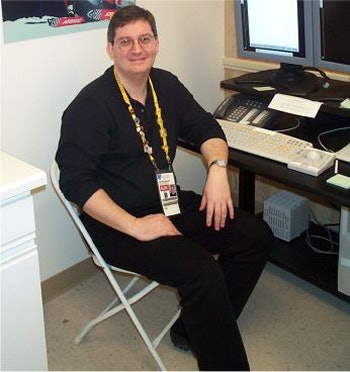
SALT LAKE CITY - Consulting with oncology patients in his daily practice, Dr. Ken Buckwalter has learned to steel himself to deliver bad news when he wished matters were otherwise. But experience can't always make it easier. Here at the Polyclinic, the emotional response of a figure skater to her competition-ending MRI results moved him deeply.
"She cried so hard during the exam that the scans were motion-degraded," Buckwalter said. "You could just tell that she knew it was bad news. It’s practically heartbreaking. It’s not necessarily at the same level as telling someone that they have cancer, but, at the that moment, (the athletes’) lives are shattered."
Buckwalter, who is an associate professor at the Indiana University School of Medicine in Indianapolis and the section chief of musculoskeletal imaging, began his run at the Polyclinic on February 10. Although business at the Polyclinic got off to a slow start initially, traffic picked up in Buckwalter’s first few days.
 |
| Dr. Ken Buckwalter of the Indiana University School of Medicine often has an audience during reading sessions at the Olympic Polyclinic. |
While most radiologists will say that time is precious, Buckwalter noted that the time crunch seemed especially severe at the Games. Reading scans with an audience looking over his shoulder -- team doctors, consulting physicians, coaches -- has required some getting used to.
"Everybody is very anxious and tightly wound, and that has a tendency to rub off on us. There is so much riding on this, so you want to really be systematic in your read, but they want the answer right away," Buckwalter said.
But offering a quick answer to athletes and their handlers isn’t always feasible, for two main reasons, Buckwalter said. First, there is the assumption that an MRI is an easy exam to undergo.
"They expect MRI to be like CT. You push the patient in the scanner and they just move along. You can keep pushing them through the gantry and get slice after slice. But that’s obviously not the case with MRI," he explained.
In addition, the extent of injuries in high-caliber athletes tends to be more extensive, requiring a more diligent look on the part of the radiologist, he added. "It may take us 10 minutes to look at an ankle and to really do a thorough job. You don’t want to miss anything, but everybody wants to know every little detail right away," he said.
Given the emotional impact the imaging information will have on the Olympians, Buckwalter has made it his business to be extra careful and conscientious in his reading. Despite the anxious atmosphere, Buckwalter said he would be sad when his time at the Polyclinic comes to an end on Saturday. "To be able to come here, it’s been a privilege and an honor, but most of all, it’s just really cool."
By Shalmali Pal
AuntMinnie.com staff writer
February 15, 2002
Copyright © 2002 AuntMinnie.com


.fFmgij6Hin.png?auto=compress%2Cformat&fit=crop&h=100&q=70&w=100)




.fFmgij6Hin.png?auto=compress%2Cformat&fit=crop&h=167&q=70&w=250)











